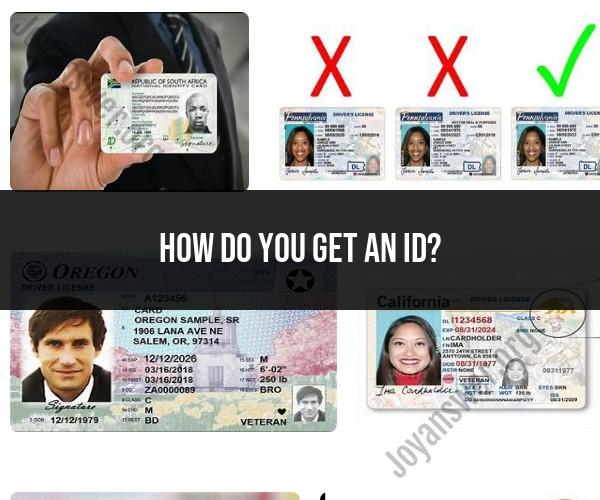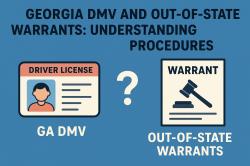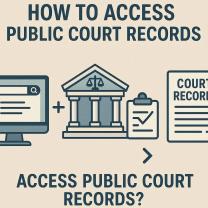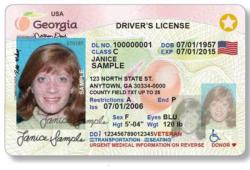How do you get an ID?
Obtaining an identification (ID) card typically involves several steps, and the specific requirements and procedures can vary depending on your location and the type of ID you need. Here is a general step-by-step guide on how to get an ID:
Determine the Type of ID You Need:
- Identify the specific type of ID you require. Common types of IDs include government-issued IDs, driver's licenses, state IDs, and passport cards.
Check Eligibility and Requirements:
- Research the eligibility criteria and requirements for obtaining the ID. Requirements often include proof of identity, proof of residency, and, in some cases, proof of citizenship or legal status. Check with the relevant issuing authority to understand what is needed.
Gather Required Documents:
- Collect the necessary documents based on the requirements for the ID you're applying for. Common documents may include:
- Proof of identity (e.g., birth certificate, passport, social security card).
- Proof of residency (e.g., utility bills, lease agreements).
- Proof of legal status or citizenship (if applicable).
- Any additional documents specified by the issuing authority.
- Collect the necessary documents based on the requirements for the ID you're applying for. Common documents may include:
Visit the Issuing Authority:
- Go to the local office or agency responsible for issuing the type of ID you need. This could be a Department of Motor Vehicles (DMV) for driver's licenses or state IDs, a passport office for passport cards, or a government ID office for other government-issued IDs.
Complete the Application:
- Obtain an application form for the ID, and fill it out accurately and completely. Be sure to provide all necessary information and attach any required documents.
Pay Fees:
- Pay any applicable fees associated with obtaining the ID. Fees can vary widely depending on the type of ID and your location. Check with the issuing authority for fee details.
Provide Biometric Data (if applicable):
- Depending on the type of ID, you may need to provide biometric data such as fingerprints or a photograph. Follow the instructions provided by the issuing authority.
Submit Your Application:
- Submit your completed application, along with all required documents and fees, to the issuing authority. You may need to schedule an appointment or wait in line at the office.
Verification and Processing:
- The issuing authority will verify your documents and process your application. This may take some time, so be prepared for a potential wait.
Receive Your ID:
- Once your application is approved and processed, you will be issued the ID. Some IDs may be provided immediately (e.g., state IDs), while others (e.g., passports) may be mailed to you.
Store Your ID Securely:
- Safeguard your ID card by keeping it in a secure place. IDs are important documents for identification purposes, so it's crucial to prevent loss or theft.
It's important to note that the specific steps and requirements can vary by country, state, or jurisdiction. Always consult the official website or contact the relevant government agency for the most accurate and up-to-date information on obtaining an ID in your area.
How to Get an ID: A Comprehensive Guide for Beginners
An identification card (ID) is a document that proves your identity. It can be used for a variety of purposes, such as opening a bank account, applying for a job, or renting an apartment. There are many different types of IDs, but the most common type is a government-issued ID, such as a driver's license or passport.
From Application to Issuance: The ID Acquisition Process
The process of obtaining an ID varies depending on the type of ID and the country or state in which you live. However, there are some general steps that are common to most ID applications:
- Fill out an application form. This form will typically ask for your personal information, such as your name, address, and date of birth. You may also need to provide proof of residency and/or citizenship.
- Pay an application fee. The fee varies depending on the type of ID and the government agency issuing it.
- Provide supporting documentation. This may include things like your birth certificate, Social Security card, and/or passport photo.
- Have your photo and fingerprints taken. This is required for most government-issued IDs.
- Wait for your ID to be issued. The processing time can vary depending on the type of ID and the government agency issuing it.
Securing Your Identification: Steps to Obtain an ID
Once you have received your ID, it is important to keep it safe and secure. Here are some tips:
- Keep your ID in a safe place. Do not carry your ID with you unless you need it. When you do need to carry it, keep it in a secure location, such as a wallet or purse.
- Do not give your ID to strangers. Only give your ID to trusted individuals, such as government officials or law enforcement officers.
- Report a lost or stolen ID immediately. If your ID is lost or stolen, report it to the issuing agency as soon as possible.
Additional Tips for Obtaining an ID
- If you are under the age of 18, you may need a parent or guardian to sign your ID application.
- If you have changed your name, you may need to provide documentation of your name change, such as a marriage certificate or court order.
- If you are homeless, you may be able to obtain a free ID from a local homeless shelter or social services agency.
If you have any questions about how to obtain an ID, you can contact the government agency responsible for issuing the type of ID you are interested in.












